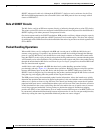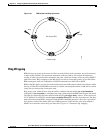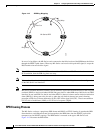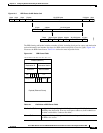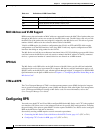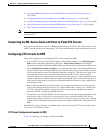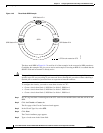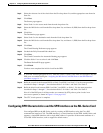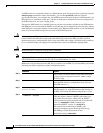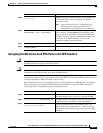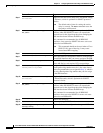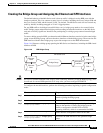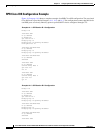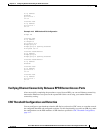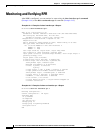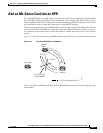
14-10
Cisco ONS 15310-CL and Cisco ONS 15310-MA Ethernet Card Software Feature and Configuration Guide R8.5
78-18133-01
Chapter 14 Configuring Resilient Packet Ring on the ML-Series Card
Configuring RPR
An SPR interface is configured similarly to a EtherChannel (port-channel) interface. Instead of using the
channel-group command to define the members, you use the spr-intf-id command. Like the
port-channel interface, you configure the virtual SPR interface instead of the physical POS interface. An
SPR interface is considered a trunk port, and like all trunk ports, subinterfaces must be configured for
the SPR interface for it to join a bridge group.
The physical POS interfaces on the ML-Series card are the only members eligible for the SPR interface.
One POS port is associated with the SONET circuit heading east around the ring from the node, and the
other POS port is associated with the circuit heading west. When the SPR interface is used and the POS
ports are associated, RPR encapsulation is used on the SONET payload.
Caution In configuring an SPR, if one ML-Series card is not configured with an SPR interface, but valid STS
circuits connect this ML-Series card to the other ML-Series cards in the SPR, no traffic will flow
between the properly configured ML-Series cards in the SPR, and no alarms will indicate this condition.
Cisco recommends that you configure all of the ML-Series cards in an SPR before sending traffic.
Caution Do not use native VLANs for carrying traffic with RPR.
Note RPR on the ML-Series card is only supported with the default LEX encapsulation, a special
CISCO-EOS-LEX encapsulation for use with Cisco ONS Ethernet line cards.
RPR needs to be provisioned on each ML-Series card that is in the RPR. To provision RPR, perform the
following procedure, beginning in global configuration mode:
Command Purpose
Step 1
Router(config)# bridge irb
Enables the Cisco IOS software to both route and bridge
a given protocol on separate interfaces within a single
ML-Series card.
Step 2
Router(config)# interface spr 1
Creates the SPR interface on the ML-Series card or
enters the SPR interface configuration mode. The only
valid SPR number is 1.
Step 3
Router(config-if)# spr station-id
station-ID-number
Configures a station ID. The user must configure a
different number for each SPR interface that attaches to
the RPR. Valid station ID numbers range from 1 to 254.
Step 4
Router(config-if)# spr wrap
{ immediate | delayed }
(Optional) Sets the RPR ring wrap mode to either wrap
traffic the instant it detects a SONET path alarm or to
wrap traffic after the delay, which gives the SONET
protection time to register the defect and declare the link
down. Use immediate if RPR is running over
unprotected SONET circuits. Use delayed for
bidirectional line switched rings (BLSR), path
protection, multiplex section-shared protection ring
(MS-SPRing), or SNCP protected circuits.
The default setting is immediate.



